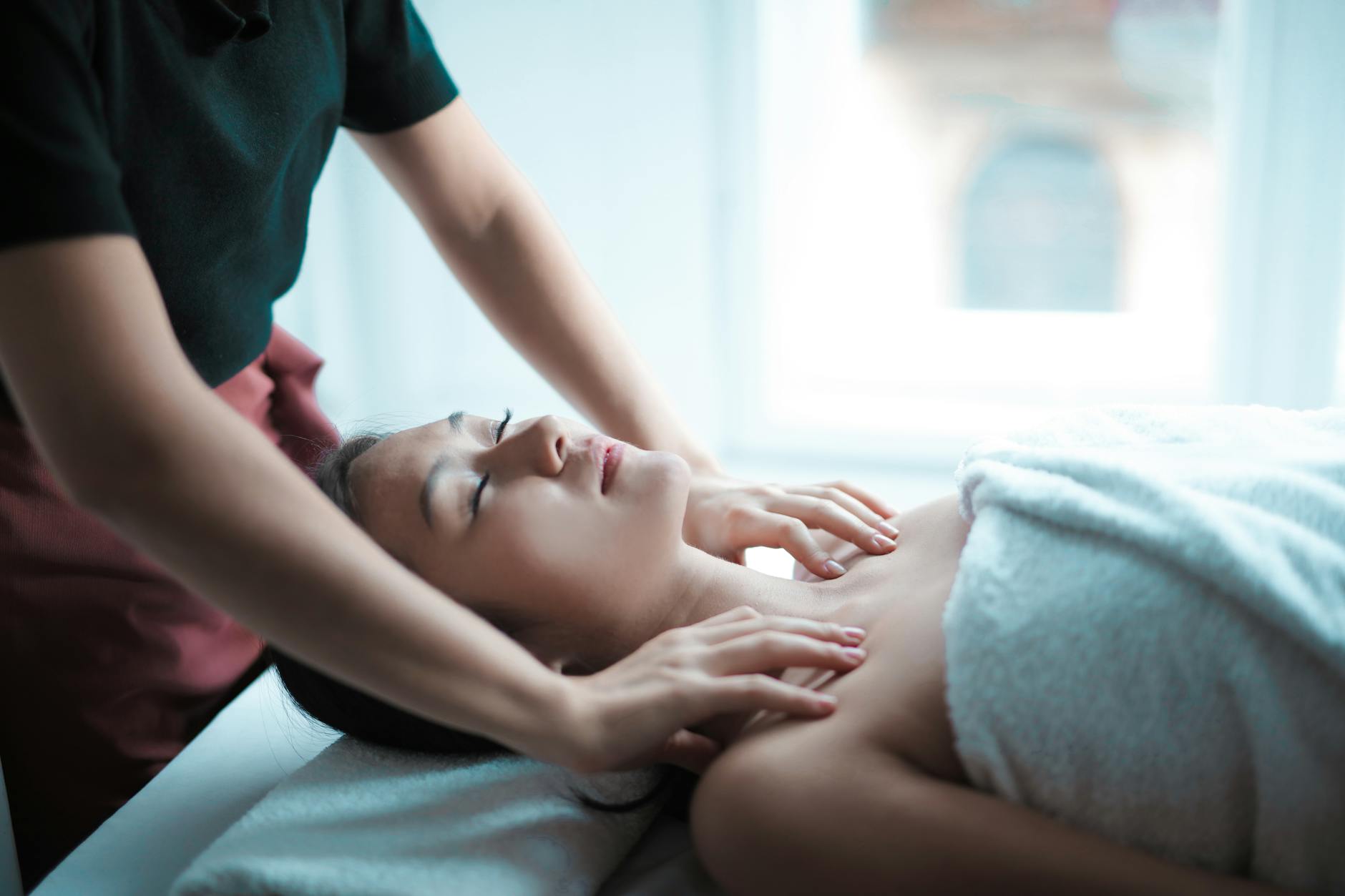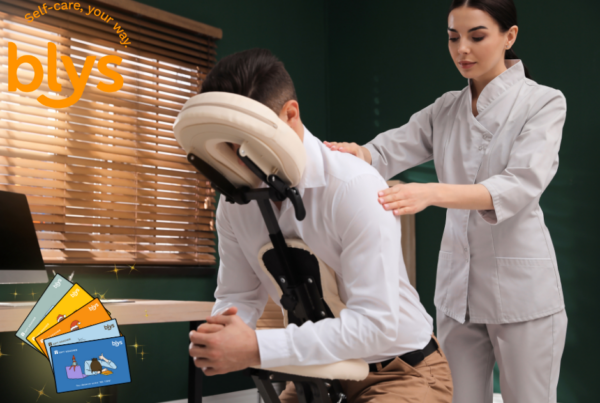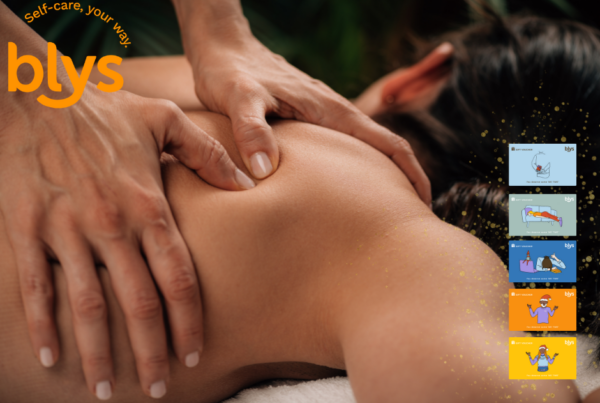Today’s “office athletes” spend hours sitting at a desk, then push their bodies hard in the gym. But long periods of sitting tighten hip flexors, weaken glutes, and round the shoulders, setting the stage for poor movement and preventable strain. These imbalances can limit performance no matter how often you train.
Sports massage helps bridge that gap. By targeting areas stressed by both sitting and exercise, it restores flexibility, boosts circulation, and supports faster recovery. For active professionals balancing work and workouts, it’s a simple way to keep your body mobile, strong, and ready to perform in the office and beyond.
How Desk Work Impacts Your Body and Performance
Long hours at a desk gradually alter how your body functions. Sitting shortens the hip flexors and hamstrings, weakens the glutes, and rounds the shoulders, creating the classic “tech neck” posture. These imbalances restrict movement, reduce stability, and increase the risk of strain when you train.
For active professionals, the effects are easy to spot. Runners often deal with IT band tightness and hip pain, while lifters struggle with shoulder mobility. Cyclists may feel lower back tension from tilted pelvic alignment. Even regular yoga or Pilates sessions can’t fully offset the stiffness built up from desk life.
Research shows that prolonged sitting weakens postural muscles and compresses spinal discs. Over time, this not only causes discomfort but also limits performance and recovery.
Regular movement breaks, better posture, and targeted sports massage can help reverse these effects and keep your body ready to perform both at work and in training.
Why Sports Massage Is a Game-Changer for Desk Workers
Sports massage goes beyond relaxation; it actively restores how your body moves and recovers. By improving circulation, breaking up muscle adhesions, and boosting flexibility, it counteracts the strain of sitting and training back-to-back.
Research shows that massage enhances range of motion and speeds up recovery for regular exercisers.
For desk-bound professionals, it targets five key problem areas:
- Hip flexors release tightness for a smoother running stride.
- Glutes reactivate weak muscles for balanced hip stability.
- Shoulders and chest ease tightness to improve lifting form.
- IT band and thigh exercises reduce tension from sitting and cycling.
- Spine and neck decompress pressure from hours at the desk.
Together, these benefits improve posture, prevent injury, and help every workout feel more efficient. For anyone juggling office hours with active training, sports massage is essential maintenance for a body that works as hard as you do.
Like in our sports massage guide for weekend warriors, regular recovery helps desk workers stay balanced, mobile, and ready for every workout.
Sport-Specific Massage Focus for Active Professionals
Not every workout stresses the body the same way. For active professionals who sit all day and train hard after hours, sports massage works best when tailored to your sport and muscle demands.
Here’s how targeted treatment supports different training types.
Runners
Prolonged sitting shortens hip flexors and tightens calves and hamstrings, leading to reduced stride length and overuse injuries. Sports massage helps release these muscles, restore flexibility, and improve running mechanics.
A Central London-based desk worker training for a half marathon might notice smoother strides and less post-run soreness after targeted hip and calf work.
Lifters and CrossFitters
Desk posture limits shoulder mobility and strains the upper back, which can affect pressing and overhead lifts. Massage that focuses on the chest, lats, and scapular region helps open the shoulders, improve alignment, and prevent injury.
A East London CrossFitter who spends long hours at a computer may feel more stable overhead after regular shoulder and trap treatments.
Cyclists
Cycling reinforces tight hip flexors and IT bands especially for those already sitting all day. Deep tissue massage on the hips, glutes, and thighs eases pressure on the lower back and improves pedalling efficiency.
Many cyclists find hip-focused sessions help reduce numbness and fatigue on longer rides.
Desk Yogis and Pilates Enthusiasts
Even mindful movers can feel stiffness from desk work. Massage for the lower back, core, and neck improves spinal mobility and balance.
A North London marketing manager who does Pilates after work may flow more easily through poses once tightness in the lumbar area is released.
Every session targets the muscles that work hardest and those that sit idle, helping your body move freely, recover faster, and perform better across all training styles.
As shared in our guide on what to expect from a sports massage, knowing how each session works helps desk workers get the most from every treatment and recovery plan.
Timing Your Massage Around Work and Workouts
Balancing desk time with training means recovery has to be intentional. The right timing for your sports massage can make every session more effective improving circulation, mobility, and recovery without overloading your body.
Here’s how to plan your sessions:
- Lunchtime reset: A short midday massage helps undo desk tension, loosen tight hips, and refresh posture before the afternoon slump.
- Evening recovery: Scheduling your massage a few hours after a workout aids muscle repair, eases soreness, and improves flexibility. Research found post-exercise massage enhances recovery and reduces fatigue more than rest alone.
- Pre-event tune-up: Book 24–48 hours before a competition or long training day to activate muscles and boost movement readiness.
- Weekly maintenance: Consistent sessions once or twice a week help offset the strain of long sitting hours and keep performance steady.
- Avoid back-to-back strain: Skip deep tissue sessions immediately before or after intense training to prevent overstimulation and allow muscles to adapt.
Matching your massage schedule to your work and workout rhythm ensures your body stays balanced, mobile, and ready for both deadlines and deadlifts.
Combining Sports Massage with Desk Ergonomics
Sports massage works best when supported by good desk habits. Without daily posture care, tightness and strain can quickly return. Simple ergonomic adjustments help maintain flexibility, ease tension, and protect the gains from your sessions.
Safe Work recommends proper workstation setup and frequent movement to prevent muscle strain. Here’s how to balance daily habits with recovery:
|
Desk Habit |
What to Do | How It Helps |
| Screen height | Keep monitor at eye level |
Prevents neck and shoulder strain |
|
Chair alignment |
Sit with feet flat, knees at 90°, lumbar supported | Reduces lower-back and hip tension |
| Keyboard and mouse | Keep elbows close, wrists straight |
Minimises shoulder and wrist stress |
|
Micro-breaks |
Move or stretch every 30–45 minutes | Boosts circulation and mobility |
| Hydration | Keep water within reach |
Aids muscle recovery and reduces fatigue |
Pairing these habits with regular Blys sports massage sessions helps your posture stay strong and your body move freely at your desk, in the gym, and beyond.
The Mobile Advantage for Busy Professionals
Busy professionals rarely have time to travel for recovery; that’s why Blys brings expert care to you. With qualified, vetted, and insured therapists available nationwide, you can enjoy professional sports massage sessions wherever you are, without interrupting your routine.
Here’s how Blys fits effortlessly into your lifestyle:
- Book in minutes: Choose your therapist, time, and location online; no calls or waiting required.
- Flexible locations: Enjoy your session at home, in the office, or even in your hotel room.
- Qualified therapists: All Blys professionals are fully trained, vetted, and insured for peace of mind.
- Stress-free recovery: No post-massage travel – rest, hydrate, and let your body recover immediately.
- Tailored sessions: Whether you’re easing desk tension or recovering from a workout, your therapist adjusts every treatment to your needs.
This flexibility lets you make recovery part of your lifestyle, not a chore on your to-do list. With Blys, time-poor but health-focused professionals can perform better, move easier, and feel their best throughout the week.
Get professional recovery without leaving your desk. Book your next sports massage with Blys today.
How Often Desk Workers Should Book a Sports Massage
The right massage frequency depends on how much you train and how long you sit. For desk workers who stay active, regular sessions help prevent muscle imbalances from returning and keep recovery consistent.
According to research, ongoing soft tissue therapy supports flexibility, circulation, and reduced soreness when done routinely rather than occasionally.
Here’s a simple guide:
- Training 3–5 times per week: Book a sports massage every 1–2 weeks to maintain muscle balance, ease post-workout fatigue, and reduce tightness from sitting.
- Moderately active or sedentary workers: Every 2–3 weeks helps correct posture, improve blood flow, and prevent stiffness from prolonged desk hours.
- During intense training cycles or recovery phases: Weekly sessions can help the body adapt to higher physical demands and reduce the risk of overuse injuries.
The ideal frequency also depends on your workload, stress levels, and recovery habits. Someone training hard but sitting eight hours a day may benefit from shorter, more regular sessions, while lighter exercisers may need less frequent maintenance.
By keeping a consistent schedule with Blys, you’ll notice smoother mobility, better posture, and improved performance, helping your body stay strong through both work and workouts.
Move Better, Work Better, Live Better With Blys
Sitting all day and training hard can take a toll, but sports massage helps bring your body back into balance. By easing tight hips, loosening shoulders, and improving flexibility, it offsets the strain of desk work while supporting better movement, recovery, and performance. The result? You feel stronger at the gym, more focused at work, and more comfortable throughout your day.
Regular care keeps small issues from becoming big setbacks. With consistent sports massage and good posture habits, you can move freely, reduce stress, and protect your long-term health even with a busy schedule.
Ready to bridge the gap between your desk and your workouts? Book a professional sports massage through Blys today and perform at your best, wherever you work or train.






